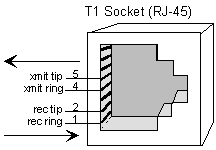Dialogic® Brooktrout® TR1034 Fax Boards - more articles
Ordering T1/RBS Service
See also: Hardware Installation Guides (including cabling)
Ordering T1 Robbed Bit Signalling (RBS) Service for a Dialogic® Brooktrout® TR1000 Media Board or Dialogic® Brooktrout® TR1034 T1 Fax Board
| Product Manufacturer: |
Dialogic Corporation (formerly: Brooktrout Technology) |
| Products: |
Dialogic® Brooktrout® TR1000 Media Board (“TR1000 Board”) and Dialogic® Brooktrout® TR1034+PxH-T1 Fax Board (“TR1034 Board”) where ‘x’ denotes a 4, 8, 16, or 24-channel board |
| T1 Service Type: |
Robbed-Bit Signaling (RBS), four-wire (note 1) |
| Signal Protocol: |
E&M Wink (generally used) or E&M Immediate (note 2) |
| Line Coding: |
B8ZS (generally used) or AMI |
| Frame Mode: |
Extended Super Frame (ESF)(generally used) or Super Frame (SF) / D4 |
| Channels: |
1-24 |
| Dial Tone: |
Optional |
| CSU: |
NONE on-board. (note 3) |
| DNIS Digits: |
DTMF (generally used) or Pulse |
| Wall Jack Required: |
USOC-RJ-48C |
| Connector on TR1000/TR1034 Board: |
see note 4 below |
Note 1: Additional information on 'T1 Service Type': When using a Brooktrout TR1000/TR1034 Board, the type of T1 line that must be supplied is a Robbed-Bit Signaling (RBS) T1 line, which also may be described as an A/B signaling T1 line, or an E&M tie trunk. This type of signaling is in-band, meaning the signaling information is carried on the same channel as the traffic. The physical connection must be a 4-wire connection; no other type of physical connection is supported by the Brooktrout TR1000/TR1034 Board.
Note 2: Additional information on 'Signal Protocol': The Brooktrout TR1000/TR1034 Board needs the signal protocol to be consistent across all T1 channels, in both directions. By 'E&M', it is meant that the signaling bits do whatever the A-bit does.
Note 3: Additional information about 'CSU':
The FCC requires an external CSU/DSU device to be installed on any T1 digital line supplied directly from your local telephone service provider.
Note 4: Connecting the Brooktrout TR1000/TR1034 Board to T1 Telephone Service  Connecting the Brooktrout TR1000/TR1034 Board to T1 Telephone Service
Connecting the Brooktrout TR1000/TR1034 Board to T1 Telephone Service If your telco or service provider or PBX support personnel are not familiar with the Brooktrout TR1000/TR1034 Board, and thus are not sure how to treat it, you may tell them to view the Brooktrout TR1000/TR1034 Board as a PBX. The telco or service provider should set up a 'tie trunk', or 'tie line', from its side to the Brooktrout TR1000/TR1034 Board, just as if it were setting up a line to a PBX. The service must be 'tie line' or 'tie trunk'. Off-premise 'extensions', or 'stations', are not supported.
Cable note:
Although standard CAT-5 (unshielded) cable will work in many situations, Shielded Twisted Pair (STP) cabling can be used to provide protection against electrical interference, particularly on longer cable runs.
Additional information on signal regeneration, and CSUs:
The cable length between the last signal regeneration point on the T1 circuit and its termination point (the connector on the Brooktrout TR1000/TR1034 Board) determines whether you must connect the Brooktrout TR1000/TR1034 Board to an external CSU (Channel Service Unit) or directly to a T1 circuit.
If the last point of signal regeneration on the T1 circuit is less than 500 feet in cable length from the Brooktrout TR1000/TR1034 Board, you do not need to connect the Brooktrout TR1000/TR1034 Board to a CSU. If the cable length from the Brooktrout TR1000/TR1034 Board to the last point of signal regeneration exceeds 500 feet (even if installed behind an in-house PBX system), you must connect the Brooktrout TR1000/TR1034 Board to an external CSU device and the CSU to the T1 circuit.
See also:Ordering DID Telephone Service
Ordering T1-PRI (Primary Rate ISDN) Service
Direct In-Bound Fax Routing Utilizing DTMF Tones
PBX Set Up for T1 Robbed-Bit Service
First published: 05-Sep-2008
Last published: 12-Sep-2008
Open access: Product rule: logon; Page rule: open

